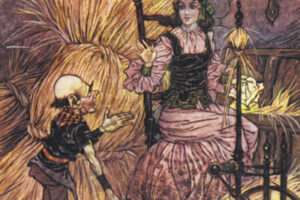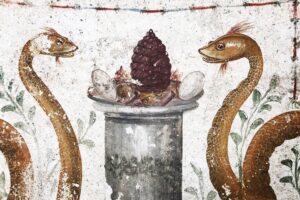
The Delphic oracle and the chthonian cult of Apollo
The Delphic oracle and the chthonian cult of Apollo
by Hasan Andrea Abou Saida
γνῶθι σαυτόν, or “Know in yourself”: this was the maxim written on the pediment of the temple of Apollo at Delphi, a warning to all those who entered the sacred temple in search of answers from the oracle.
For more than a thousand years, Delphi was a sacred place of ‘hierogamy’, of the union between the sky god Uranus and the earth god Gaea.The foundation of the city and its oracle took place in ancient times, much earlier than Greek authors have reported in their writings. Here stood the sacred complex connected with the sanctuary of the sun god Apollo, where for centuries the oracle was worshipped and consulted not only by the Greeks, but also by numerous other peoples. But long before the Apollonian cult, around the 16th century B.C. during the Mycenaean Bronze Age, Delphi was originally dedicated to the cult of the earth goddess, the goddess Gea or Gaia, progenitor of the Titans and the Olympian gods. The name Delphi is in fact derived from the same root as δελφύς, “womb”, indicating the archaic veneration of Gaia at the site 1. It was his oracles that guided Zeus’ rise to sovereignty.
The priestesses of Mother Earth prophesied the first responses in a cave on Mount Parnassus, whose pre-Hellenic name, originally Parnašša, is said to derive from Hittite and Luvic parna, meaning “house”, “dwelling” 2. The Greeks regarded the mountain and the city of Delphi itself as the centre of the world and the Universe, the seat of the Omphalos or navel of the world, an egg-shaped stone that was located in the innermost part of the sanctuary in ancient times. The Omphalos, as a stone vomited by the titan Krónos, was placed by Zeus in the valleys below the Parnassus yokes, to be a sign for the future, a prodigy for mortal men. In an ancient legend, it is said that two eagles (or two swans), departing from the ends of the earth and heading for its centre, met there, in divine Delphi, the centre of conjunction between the earthly and celestial energies of Ancient Greece. According to historians, two golden eagles were placed on either side of it in memory of the feat performed by the two birds of prey 3. Clustered around the Delphic Omphalos is the serpent Pytho, the guardian of the womb of which it is itself a totemic manifestation. According to Homer himself, the name of the oracle was formerly Pytho, from the ancient Greek Πυθώ, the Pythia, the incarnation of the Pythoness, the chthonic enemy who was killed by the god Apollo on a mission of vengeance and conquest of the sanctuary 4.
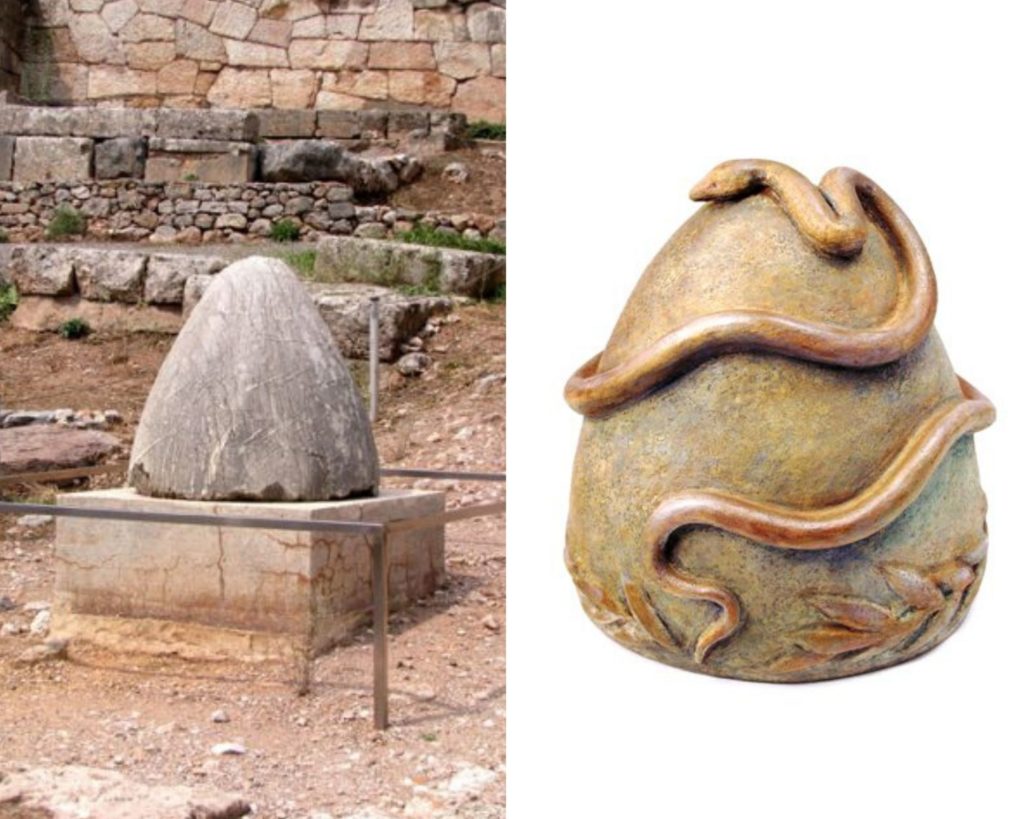
In one of the most famous Greek legends, we read how Apollo, shortly after his birth from his mother Latona on the island of Delos, left for Mount Parnassus where Python lived. The god attacked the serpent-dragon, son of Gaea, and killed him with arrows, finally taking possession of the oracular seat dedicated to the Earth. Because of this outrage, Gaea asked Zeus for help, who ordered Apollo to be purified in Tempe and to institute games in Delphi called “Pythian”, in honour of the sacred Python. After his purification, Apollo went to the god Pan, from whom he obtained the secrets of the art of divination, and forced the priestess of Mother Earth, called Pythia or Pythoness, to serve him. Because of this feat, the god earned the name Pythius, becoming “Apollo Pythius or Pythian“ 5.
But the oldest sources, such as the Homeric hymns to Apollo and some artistic representations, also mention a female snake (drakaina), Dauphine (Δελφινης), guardian of the oracle and from whose name Delphi/Delphus would derive. The appearance and attributes of this serpent are confused, perhaps deliberately, with those of Echidna, a beautiful woman with a snake’s tail, daughter of Ceto and Forcio, and sister of Ladone. Homer also tells us that near the dragoness lived the dragon Typhon, son of Hera, who to spite Zeus, who had conceived Athena from her head, decided to conceive a child without male help. Typhon, a monstrous creature, was entrusted by the goddess to the dragoness. Apollo then killed the serpent Dauphine and left its carcass to rot in the sunlight, in a place that was named for this reason Pito, from the Greek verb pythèin, “to rot” 6.
The figure of the serpent Python is therefore modelled on the more archaic figure of Delfina, partly taking up some of her attributes, first and foremost her role as guardian of the oracle. A role that in some older representations it retains together with Apollo, although it later becomes the defeated and killed opponent.
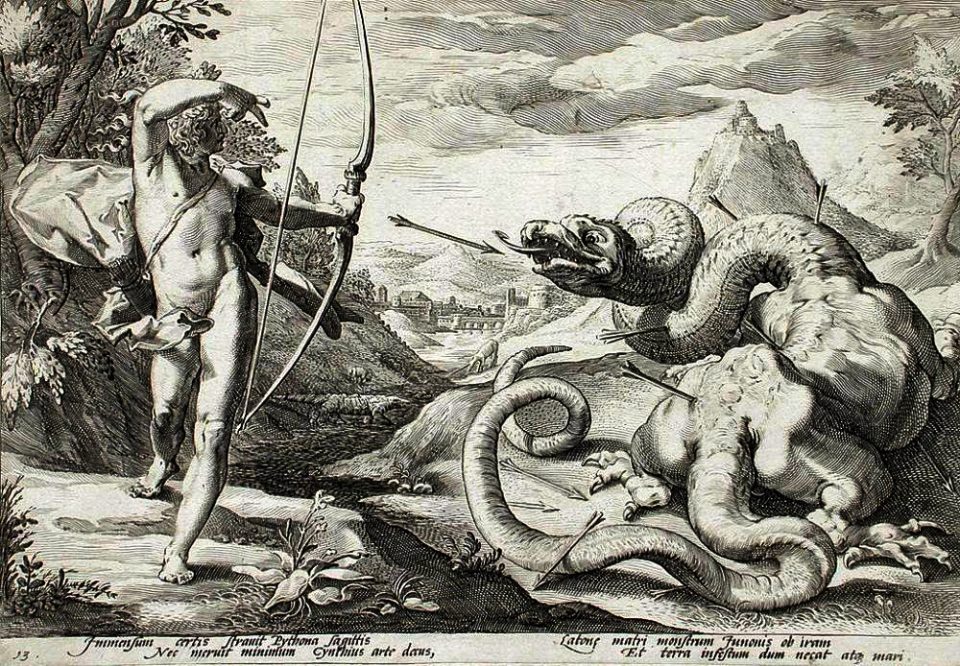
From its birth, therefore, the oracular seat was originally dedicated to the goddess Gaea, and after her, it was the Titanid Themis, her daughter, goddess of Justice and Order, who ruled the oracle. According to the Theogony, the union of Themis with Zeus gave birth to the Hours and the Moires, the weavers of life and the Destiny of mankind. The meaning of the name Themis is “unshakable”, which is perhaps why it has been identified as the personification of both legal order and eternal justice. Ovid, in the myth of Deucalion and Pyrrha, tells of the obscure response that the goddess gave to the young couple, pronouncing these enigmatic words: “Come out of the temple and throw the bones of the Great Mother behind your back”. Only later did they realise that the Great Mother was Gaea, and by throwing stones over their shoulders did they repopulate the Earth: the stones thrown by Deucalion became men, those thrown by Pyrrha, women 7. And in the third turn of fate, by the will of Themis and without any conflict, it was another titanid, her sister Phoebe, wife of Ceos and mother of Latona and Ateria, who settled in Delphi. In the Theogony, Hesiod describes the titanid with the epithets “Golden-crowned Phaebe” and “Brilliant”, recalling her function as a titanic goddess of prophecy and oracular intellect 8. Finally, it was the latter who offered the oracle, as a birth gift, to her grandson Phoîbos Apóllōn, or ‘Phoebe Apollo’. Apollo’s twin sister, the moon goddess Artemis, was also called Phoebe.
With the progressive invasions of the Indo-European peoples, tribes of shepherds and hunters, including first the Ionians and Aeolians and later the Achaeans and the Dorians in the 12th-11th centuries BC, the male Olympian deities began to replace and integrate with the female titanic deities of the pre-Hellenic Pelasgic peoples all over ancient Greece 9. The pre-Hellenics, who worshipped the Great Mother and devoted themselves to the cult of the Titans, absorbed the Ionian lineages that worshipped the gods of Olympus, such as Zeus, Hades, Poseidon and especially Apollo. This gradual change is also testified to by the archaeological finds at the sanctuary of Delphi: the female votive statuettes were progressively replaced between the 11th and 9th centuries BC by similar exclusively male simulacra 10.
Of very ancient origin, the cult of the god Apollo was one of the most famous and widespread throughout Ancient Greece and the Mediterranean basin. According to Greek historical sources, the god Apollo migrated from Lycia, a region in Anatolia, with his mother Latona. His peculiar characteristics, such as his androgynous appearance, his ineffability, his appearance as a hunter, shepherd and wolf chaser (hence the epithet ‘Apollo Lyceus’), his qualities as an ambiguous or oblique god (with the epithet ‘Apollo Lossia or Apollo Loxias’, the obscure one), but also his being the god of pestilence, healing and prophecy, derive from Semitic culture. There was in fact an important Anatolian god, known as Aplu, a terrible god, linked to illness but also to healing, a powerful archer, protector of hunting and wild animals. In addition, many Anatolian cults are linked to prophecy and priestesses (or even priests) who fall into mystical trances to prophesy, just like the priestesses of Apollo at Delphi. The Etruscan god of the sun and divination, the Italic counterpart of Apollo, was called Aplu or Apulu, recalling the archaic Anatolian sun god. Apollo himself confirms this origin, siding with the Asian and Anatolian city of Troy during the famous war described in the Iliad.
Other references in the archaic period point to probable connections between the god Apollo and the Mycenaean period. In the Minoan religion there was a lady of the animals, connected to Artemis-Diana, or even to Britomarti/Diktynna, a name of Minoan origin, who presumably should have had a male double, namely Apollo. Moreover, the priests of Apollo at Delphi called themselves Labryaden, a name that in turn refers to the double axe and the labyrinth, very important symbols in Cretan religion. The classical god Apollo would therefore be the result of a fusion between the Anatolian god and pre-Hellenic religious elements 11.
In the 9th-12th centuries BC, with the Apollonian cult already fully formed, the stone temple of Apollo was built, in which the female priestly caste, and in particular the Pythia, reflected in themselves the balance between the new and the old cult, symbolising the chthonic-lunar energy in union with the Apollonian-solar energy 12.
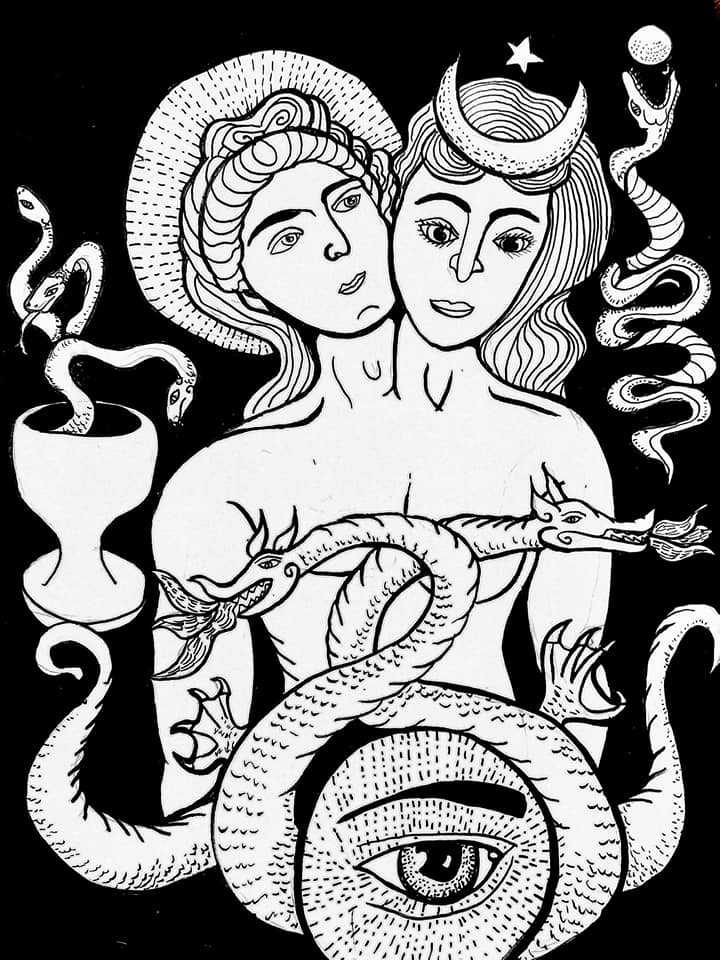
The Pythia, once reached the underground chamber under the temple called ádyton (ἄδυτον), gave her answers sitting on the tripod, inhaling toxic vapours coming from the cracks in the ground, symbol of terrestrial energy, and at the same time chewing laurel leaves, with hallucinogenic properties, symbol of solar energy, bringing her into a state of ecstatic trance. By looking at the water in a saucer resting on her left hand (the feminine lunar side) and holding a branch of laurel leaves in her right hand (the masculine solar side), the priestess would see the response and, with the voice of the god Apollo, prophesy it to the visitor who had requested it.
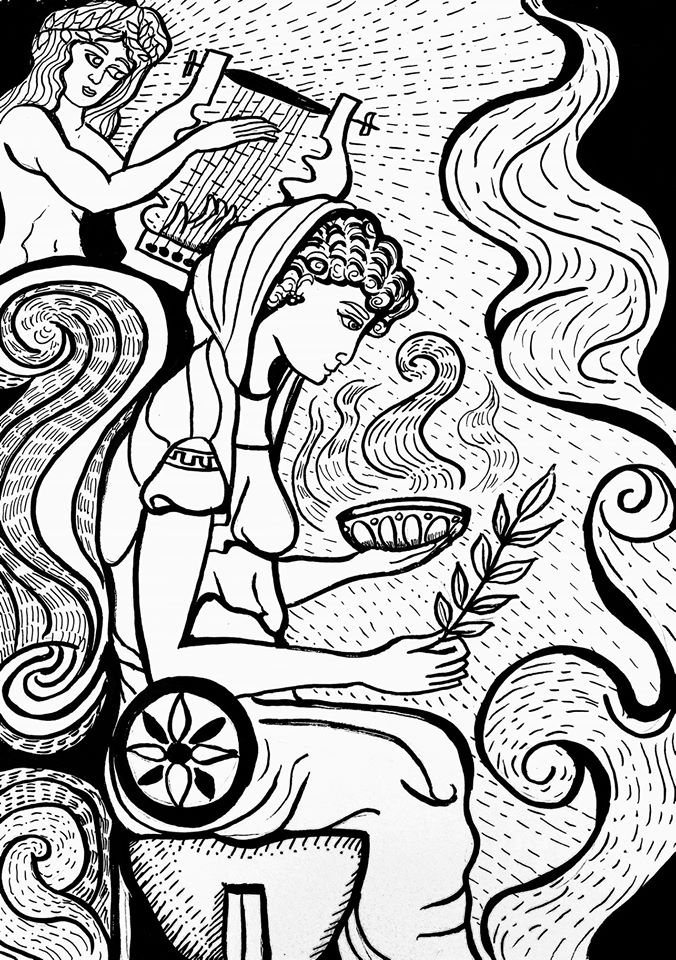
The role of the Pythia was a very demanding one, and for this task a priestess was appointed who was chosen from within the caste of the sanctuary and who, in addition to being from Delphi, had to come from an aristocratic family. Moreover, the Pythia had to be a highly educated woman, at least in ancient times: she had to have knowledge of history and literature, philosophy and geography, and show a good aptitude for the graphic arts and music. In archaic times, the Pythia pronounced oracles in Homeric verse (pentameter or hexameter) and in the Ionian dialect.
Becoming a Pythia was a much sought-after position for the women of Delphi, as it guaranteed them a number of privileges: they received a large salary, did not have to pay taxes and could own private property and participate in public events and festivals, all aspects of life that Greek women of the time were usually excluded from. However, their lives were very short and the priestesses often died young, due to the constant work with the Apollonian energy, an overly intense solar energy that inexorably consumes you 13.
Energy research carried out on a past life lived as an oracle at the sanctuary of Delphi in the sixth century BC, during the past life research project in collaboration with Andrea Nadir Orazi, has shown that all the priestesses of Apollo sought a particular inner state called the “Embrace of the Sun”, an initiatory energy practice that led the priestess on a physical level to self-burning, while on a subtle level the achievement of this goal occurred with the union of the same in the heart of Apollo. Achieving this union was considered the highest honour given by Apollo and elevated the priestess to the rank of a semi-divinity, becoming a true “daughter of Apollo”. In the exploration of this past life, a group of priestesses had attained this particular energetic state at the same time, but caused a huge fire that destroyed the sanctuary in 548 BC.
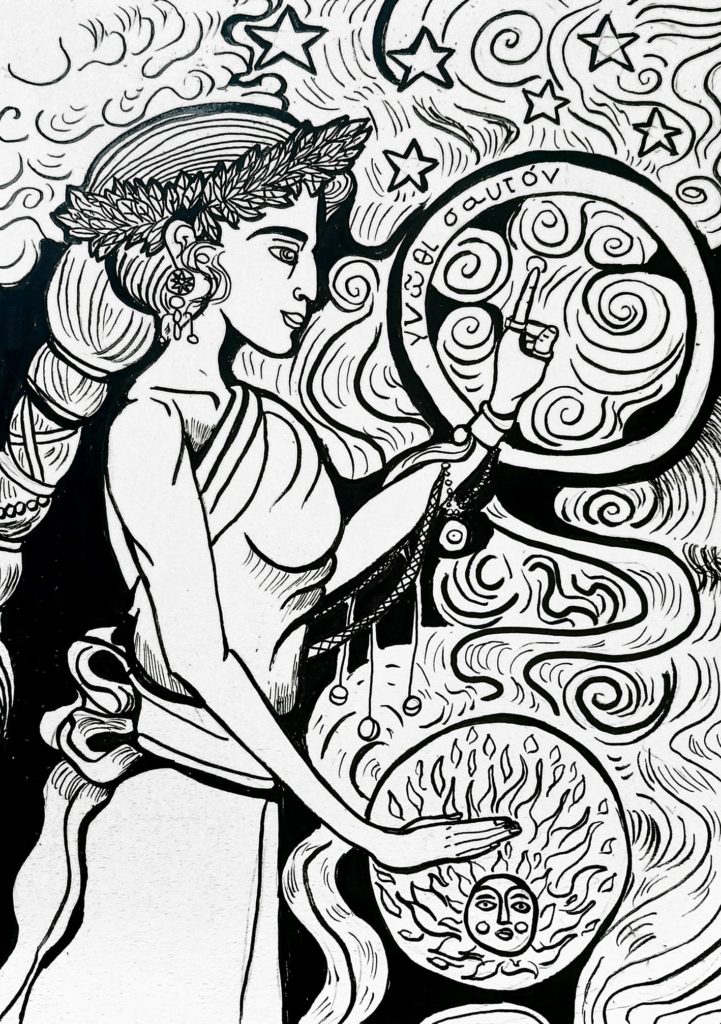
The sanctuary at Delphi, however, was not the only omphalos in Ancient Greece where the oracle resided. In fact, in Dodona, a city located in Epirus, there was an oracle dedicated to two pre-Hellenic deities: Zeus Molossos or Zeus Nàios, the god of lightning and king of Olympus, and the Mother Goddess Dione, the female form of the god Zeus. Originally, however, just as at Delphi, the site was dedicated to the goddess Gaia or Rhea. The cult, centred around the oak tree sacred to Zeus, involved the interpretation by the Selloi priests of the rustling of the leaves of the tree sacred to Zeus, in a first phase, while the priestesses prophesied in a very similar way to what took place in the sanctuary at Delphi 14.
In addition to Dodona, another oracular sanctuary dedicated to Apollo existed at Kerameikos, northwest of the Acropolis of Athens. In 2012, thanks to an archaeological team led by Dr Jutta Stroszeck, director of the excavation of Kerameikos on behalf of the German Archaeological Institute in Athens, the oldest oracular temple dedicated to Apollo in Athens was found. An omphalos, resting on a marble slab, covered the entrance to the sacred oracular well, located in the temple of Artemis Soteira and Apollo, where the priestesses practised hydromancy, the art of divination based on the observation of water. Twenty inscriptions covering the walls of the well have also been discovered that repeat the same phrase: “ΕΛΘΕ ΜΟΙ Ω ΠΑΙΑΝ ΦΕΡΩΝ ΤΟ ΜΑΝΤEΙΟΝ ΑΛΗΘΕΣ”, which means ‘Come to me, O Paean, and bring with you the true oracle’. The name Paean is derived from the Greek παιάν (paián) – in Ionian dialect παιήων (paiéon) – meaning ‘he who heals’, the ancient Mycenaean name for Apollo 15.
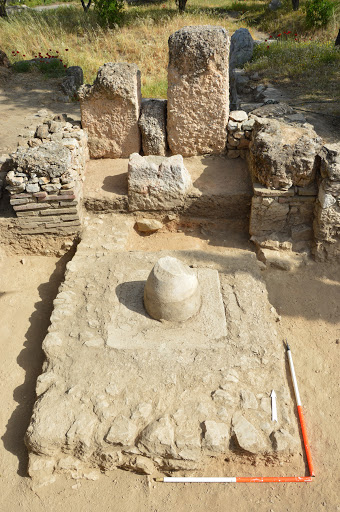
The same union between a pre-Hellenic lunar cult and an Indo-European solar cult can be found in the cave known as the “Antro della Sibilla” near Lake Avernus in Cumae, the oracular seat of the Cumaean Sibyl, one of the most important sibyls of the ancient world. The title of Cumaean Sibyl was conferred only on the highest priestess of the oracle of the god Apollo and the goddess Hecate or Hera. According to legend and some archaeological finds discovered on the site, around the 7th century BC the deity connected to the oracle was initially Hera, the great mother goddess of Olympus, whose ancient cult descended from the Minoan and Pelasgian cultures. The appellation by which the Cumaean Sibyl was called was Herophile, “friend of Hera”. In addition, there is an inscription on a bronze diskette in the Chalcis alphabet, datable to the second half of the 7th century B.C., which reads: “Hére ouk eai epimanteuesthai”, i.e. “Hera does not allow the oracle to be consulted again”, confirming that the oracle belonged to this deity. Subsequently, control of the oracular seat passed from Hera to Hecate, lunar goddess of the magical arts and psychopompa deity, and finally to the god Apollo. The Sibyl, who initially performed the oracle per sortes, began to transcribe her predictions into hexameters on palm leaves, through a state of ecstatic trance. At the end of the prediction, the leaves were mixed with the winds coming from the hundred openings of the cavern, making the vaticini “sibylline” 16.
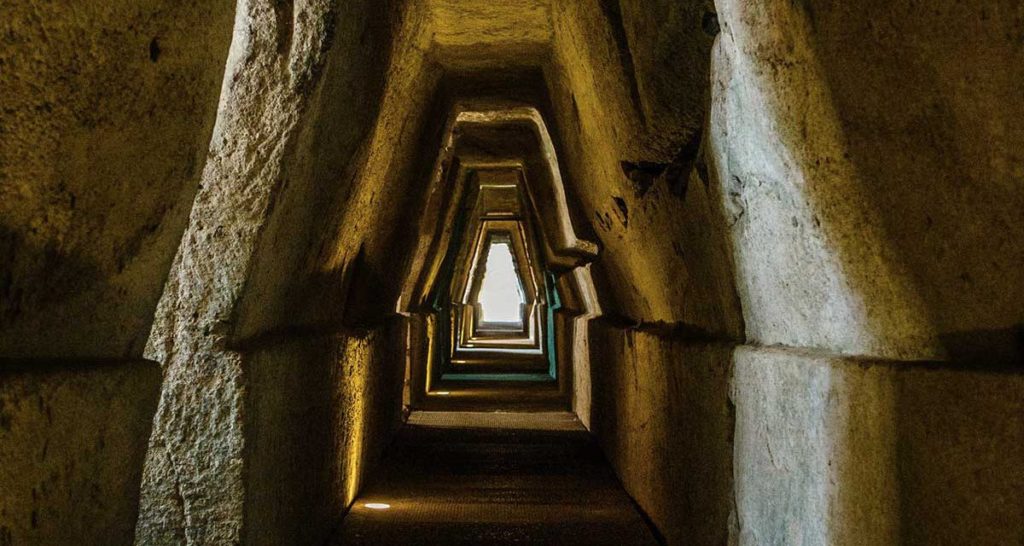
1 Delfi. (29 maggio 2020). Wikipedia, L’enciclopedia libera, https://it.wikipedia.org/wiki/Delfi (last visit 13/06/2020).
2 Parnaso. (10 aprile 2020). Wikipedia, L’enciclopedia libera, https://it.wikipedia.org/wiki/Parnaso (last visit 13/06/2020).
3 Delfi, Enciclopedia dell’Arte antica 1960, Treccani, http://www.treccani.it/enciclopedia/delfi_(Enciclopedia-dell’-Arte-Antica) (last visit 13/06/2020).
4 Pizia, Enciclopedia Italiana 1935, Treccani, http://www.treccani.it/enciclopedia/pizia_%28Enciclopedia-Italiana%29/ (last visit 13/06/2020).
5 Apollo. (20 maggio 2020). Wikipedia, L’enciclopedia libera, https://it.wikipedia.org/wiki/Apollo (last visit 13/06/2020).
6 Delfine. (6 aprile 2020). Wikipedia, L’enciclopedia libera, https://it.wikipedia.org/wiki/Delfine (last visit 13/06/2020).
7 Temi. (24 gennaio 2020). Wikipedia, L’enciclopedia libera, https://it.wikipedia.org/wiki/Temi (last visit13/06/2020).
8 Febe (titanide). (21 giugno 2019). Wikipedia, L’enciclopedia libera, https://it.wikipedia.org/wiki/Febe_(titanide) (last visit 13/06/2020).
9 Denominazioni dei Greci. (5 marzo 2020). Wikipedia, L’enciclopedia libera, https://it.wikipedia.org/wiki/Denominazioni_dei_Greci (last visit 13/06/2020).
10 Margherita Bottino, La divinazione nell’antichità classica [1] in Agorà VII, ottobre-dicembre 2001.
11 Apollo. (20 maggio 2020). Wikipedia, L’enciclopedia libera, https://it.wikipedia.org/wiki/Apollo (last visit 13/06/2020).
12 Tempio di Apollo (Delfi). (3 agosto 2019). Wikipedia, L’enciclopedia libera, https://it.wikipedia.org/wiki/Tempio_di_Apollo_(Delfi) (last visit 13/06/2020).
13 L’Oracolo di Delfi, il più famoso e temuto centro oracolare del mondo greco, Cronistoria, https://cronistoria.altervista.org/loracolo-di-delfi-il-piu-famoso-e-temuto-centro-oracolare-del-mondo-greco/ (last visit 13/06/2020).
14 Dodona. (2 giugno 2019). Wikipedia, L’enciclopedia libera, https://it.wikipedia.org/wiki/Dodona (last visit 13/06/2020).
15 Philippe Bohstrom, Archaeologists Find First Ancient Oracle to Apollo in Athens, Haaretz, https://www.haaretz.com/archaeology/ancient-oracle-to-apollo-found-in-athens-1.5392711 (last visit 13/06/2020).
16 Vincenzo Crosio, Cuma e il culto di Apollo medico nei Campi Flegrei, Qui Campi Fregrei, https://www.quicampiflegrei.it/2019/11/10/cuma-e-il-culto-di-apollo-medico-nei-campi-flegrei/ (last visit 13/06/2020).

